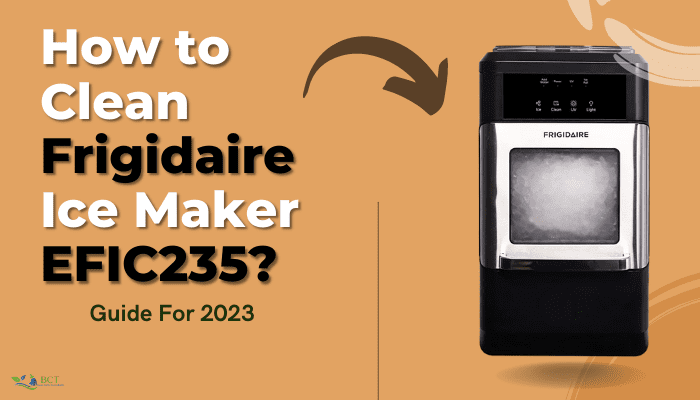With proper care, a portable ice maker can last for several years, and some models have even been known to endure up to a decade. The key to ensuring longevity is consistent maintenance, particularly through regular cleaning.
How can you best clean a portable ice maker and when should you recognize the need for it?
Continue reading to discover in-depth information about my comprehensive step-by-step manual for maintaining your portable ice maker, along with a complete list of all the necessary items required to successfully carry out the cleaning process.
Steps on How to Clean Portable Ice Maker Machine [With Vinegar]
Below, I have compiled a list of easy and quick methods for cleaning your portable ice maker. These methods have been tested and can be applied with readily available tools. Proper maintenance and cleaning are essential to ensure the longevity and optimal performance of your ice maker. Follow these steps to keep your ice maker functioning smoothly:
Gather Your Supplies:
- Vinegar/Commercial Cleaner
- Dish Soap
- Clean Cloth/Sponge
- Toothbrush
- Appropriate Opening Tool
01. Power off and unplug the ice maker.
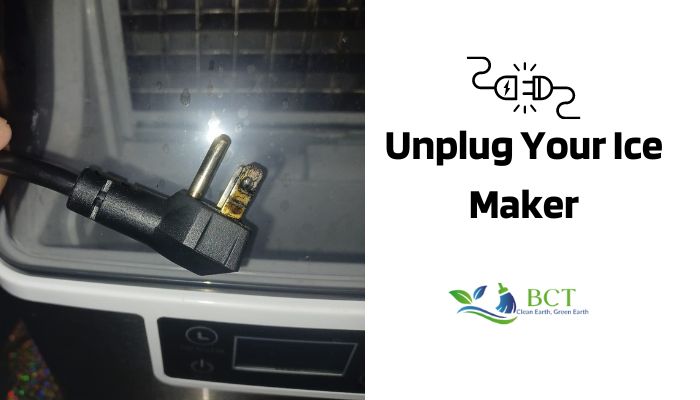
Unplug the ice maker and remove the ice basket. This will prevent any accidental electrical shocks while you are cleaning the appliance.
02. Drain the water reservoir.
Locate the drain plug on the back of the ice maker and remove it. Tilt the ice maker forward and allow the water to drain out. This will help to remove any built-up minerals or sediment from the reservoir.
03. Mix the cleaning solution.
Mix equal parts white vinegar and water (1:1 ratio) in a spray bottle. Alternatively, you can use a commercial ice maker cleaner. The vinegar will help to disinfect the ice maker and remove any hard water stains.
04. Run a cleaning cycle.
With the cleaning solution still in the reservoir, turn on the ice maker and allow it to make a batch of ice. This will help to circulate the cleaning solution throughout the ice maker.
05. Clean the ice basket.
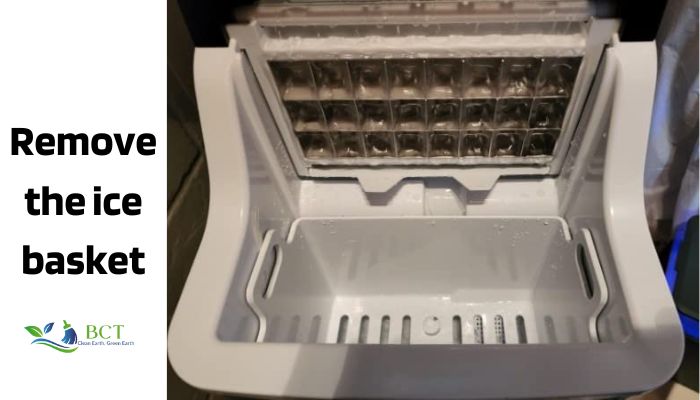
Rinse the ice basket with warm water and dish soap. Scrub it with a sponge if necessary. Be sure to remove any debris or ice that is stuck in the basket.
06. Scrub the interior of the ice maker.
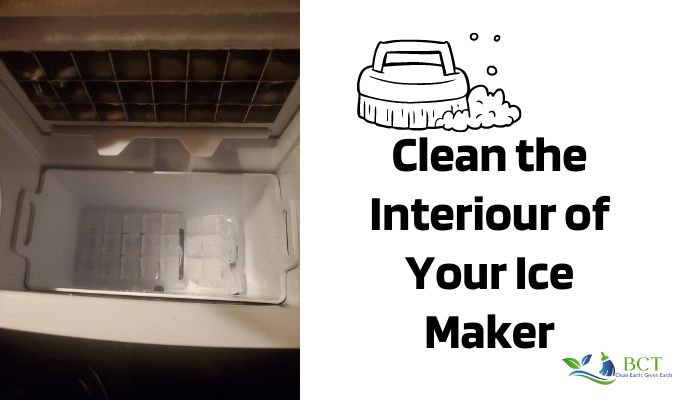
Use a clean cloth or sponge to wipe down the interior of the ice maker with the cleaning solution. Be sure to get into all the nooks and crannies, including the water inlet and outlet valves.
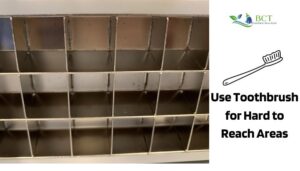
For hard-to-reach areas, use a toothbrush to dislodge any debris or buildup.
07. Rinse the interior of the ice maker.
Rinse the interior of the ice maker with warm water. Be sure to remove all of the cleaning solutions.
08. Run more rinse cycles.
Fill the reservoir with fresh water and run the ice maker for a few more cycles to flush out any remaining cleaning solution. This will help to ensure that the ice maker is completely clean.
09. Dry the interior of the ice maker.
Use a clean soft cloth to dry the interior of the ice maker. Be sure to dry all of the surfaces, including the water inlet and outlet valves.
10. Reassemble the ice maker
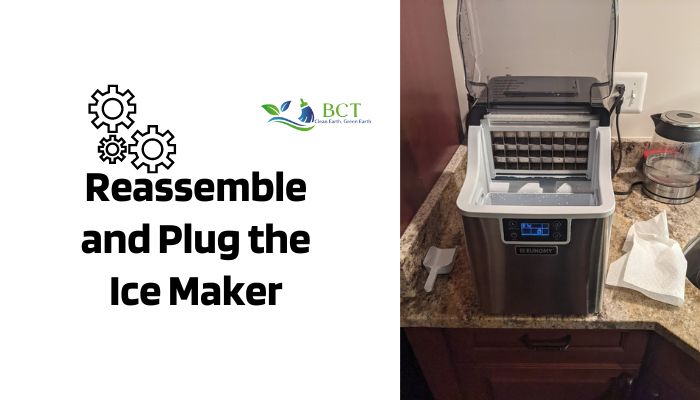
Reassemble the ice maker components accurately and securely. Plug it back in to restore power and functionality, following the manufacturer’s instructions for safe reconnection.
People also read: How to Clean Frigidaire Ice Maker EFIC235?
Tips to Keep a Portable Ice Maker Clean Longer
Here are some tips to keep your portable ice maker clean without having to go through the full cleaning process daily:
- Wipe down the exterior with a damp cloth after each use.
- Empty the ice bucket and rinse it with water after each use.
- Clean the water reservoir once a week.
- Descale the ice maker every six months to a year.
- Place the ice maker on a level surface.
- Do not overload the ice maker.
- Keep the ice maker away from heat.
Portable Ice Maker Cleaning Steps at a Glance!
| Step | Action | Short Details |
| 01 | Turn off the appliance | Ensure the ice maker is unplugged for safety. |
| 02 | Drain the reservoir | Empty the water reservoir completely. |
| 03 | Add cleaning solution | Prepare a mixture of mild cleaning solution and water. |
| 04 | Run an ice-making cycle | Initiate an ice-making cycle with the cleaning solution. |
| 05 | Clean the storage basket | Remove the basket and wash it separately with the solution. |
| 06 | Scrub your machine | Gently scrub corners and hard-to-reach areas with a brush. |
| 07 | Rinse it off | Thoroughly rinse the interior and components with water. |
| 08 | Run more cycles | Run multiple cycles with clean water to flush the system. |
| 09 | Dry the interior | Wipe down the interior with a dry cloth to remove moisture. |
| 10 | Reassemble it | Reassemble components securely. Plug in safely. |
How to Clean Portable Ice Maker With Lemon Juice? [Quick Method]

If you don’t have vinegar or prefer not to use it, you can opt for lemon juice as an alternative for cleaning your portable ice maker. Lemon juice serves as a natural cleaning solution that aids in the maintenance of your appliance. Its acidic properties assist in breaking down mineral deposits and residue, ensuring the proper functioning of the ice maker and maintaining its hygiene. To utilize lemon juice, follow these simple steps:
- Unplug the ice maker and empty the water reservoir.
- Mix equal parts lemon juice and water in a bowl.
- Use a sponge or cloth dipped in the lemon juice solution to wipe down the interior of the ice maker, including the ice bin, the water reservoir, and the ice chute.
Note: If the ice maker is very dirty, you may need to soak the parts in the lemon juice solution for a few hours before scrubbing them.
- Pay attention to any hard-to-reach areas, such as the corners and crevices.
- Rinse the interior of the ice maker with clean water.
- Wipe the exterior of the ice maker with a clean cloth.
- Let the ice maker air dry completely before using it again.
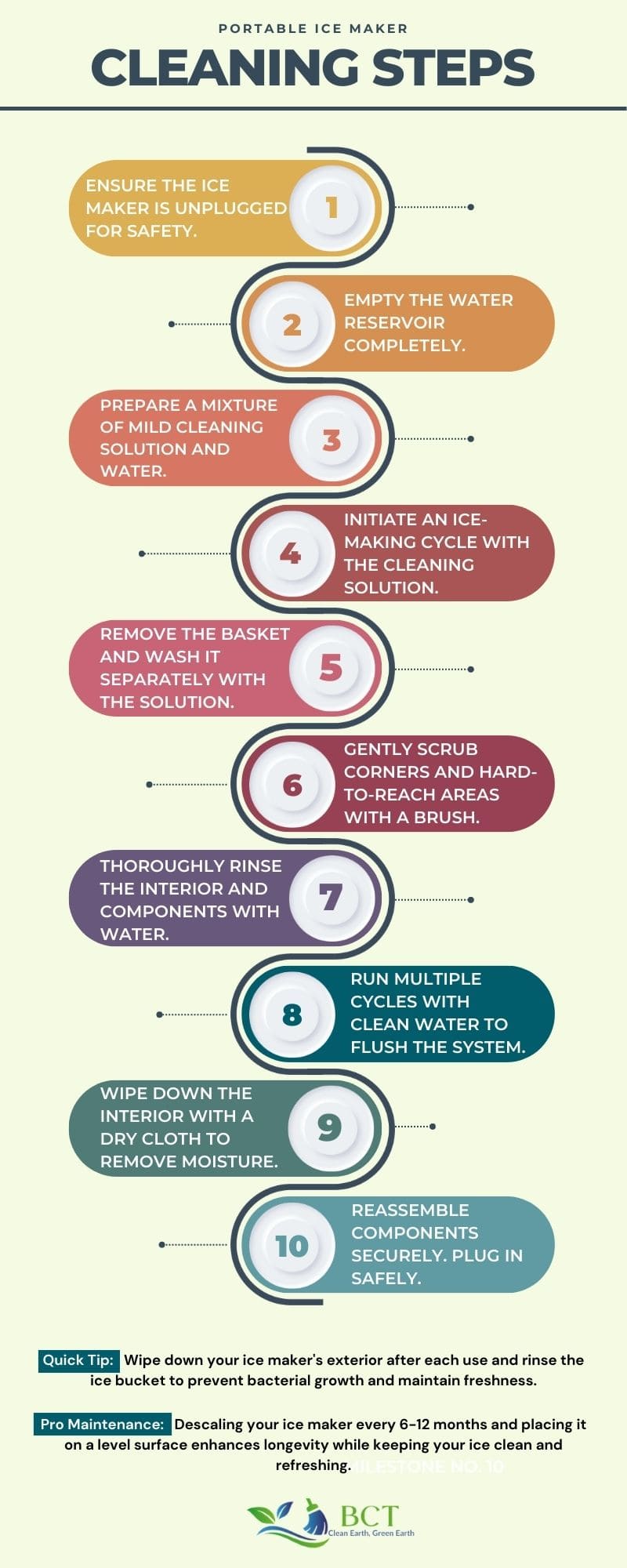
FAQs
Why Clean Your Ice Maker?
Your ice maker is a valuable appliance that helps you keep your drinks cool and refreshing. But like any appliance, it needs to be cleaned regularly to prevent the growth of bacteria and mold. Bacteria and mold can make your ice unsafe to eat or drink, and they can also damage your ice maker.
How Often Should You Clean Your Portable Ice Maker?
You should clean your portable ice maker at least once every two months, or more often if you use it frequently or if you live in an area with hard water or high humidity.
When to Clean Your Portable Ice Maker?
Some signs that it is time to clean your portable ice maker:
- The ice is cloudy or discolored.
- There is a build-up of ice or frost on the inside of the ice maker.
- You notice a strange odor coming from the ice maker.
- You see mold or mildew growing in the ice maker.
- The ice maker is not producing ice as quickly as it used to.
Can I use bleach to clean my portable ice maker?
Bleach can be used to clean a portable ice maker, but it is important to dilute it properly. Mix one part bleach with 20 parts water. Do not use undiluted bleach, as it can damage the ice maker.
What should I do if my ice maker smells bad?
If your ice maker smells bad, it is likely due to bacteria or mold buildup. To clean the smell, follow the steps above, but add a few drops of essential oil to the vinegar solution. The essential oil will help to mask the bad smell and leave your ice maker smelling fresh.
Conclusion
The longevity and optimal performance of your portable ice maker greatly depend on consistent maintenance, particularly regular cleaning. By following the step-by-step methods outlined in this comprehensive guide, you can ensure that your ice maker remains in top-notch condition for years to come.
The provided tips for ongoing maintenance can help you keep your ice maker clean and functional with minimal effort. Remember that a clean ice maker not only guarantees safe and refreshing ice but also extends the lifespan of this essential appliance.


